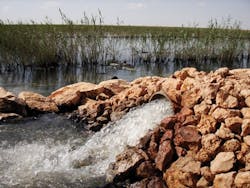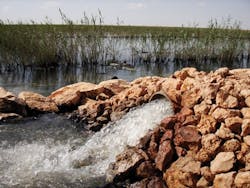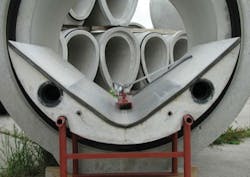Solar Sludge Drying System Helps Reduce Hauling Costs
By Bill Mattfeld
The disposal of sludge generated in wastewater plants has become an increasingly difficult problem. Traditionally, biosolids have been disposed of in landfills, incinerated, or land applied in certain designated areas. Changing regulations are requiring changes to treatment and disposal methods.
Solar drying is an alternative technology that has arisen in recent years. Since 1994, automated solar drying systems have been successfully applied in Europe at plants ranging in size from 0.2 to 40 mgd. It is estimated that there are over 200 solar biosolids dryers in operation in Europe in a variety of climates ranging from the hot and dry Spanish islands, to the snowy Alpine regions of Austria and Switzerland, to the cold and dark areas of northern Germany and the United Kingdom. With North America's more favorable climate, this technology has gained significant traction in the United States, with about 18 plants in operation or under construction.
The basic principle of operation of a solar drying system is to evaporate water from the sludge with 95% of its drying energy coming from the sun's solar energy. In many cases, biosolids are spread inside a greenhouse type structure that serves as a drying chamber. Sunlight enters the drying chamber and heats the air inside. As a result of this heating, the relative humidity inside the chamber drops which allows more water to evaporate, even on days with near 100% relative humidity. The process does not require a fuel source or skilled labor, which significantly reduces operating costs.
Prospective customers in the humid regions of the southern United States have usually viewed these claims with skepticism, so the bulk of the early installations were installed in the American West where climate conditions are generally regarded as being favorable. However, in central Florida a standard drying chamber has a capacity roughly equal to one located in the dry Sacramento region of California. The longer daylight hours, warmer winter, and more direct sunlight throughout the year makes up for the humid conditions found in the Deep South.
Case Study
The Okeechobee Utility Authority (OUA) in central Florida operates a wastewater treatment plant that treats 0.6-1.0 million gallons of wastewater per day. In the past, the sludge was processed as Class B biosolids and applied to OUA fields. Recent changes to state codes and a desire to protect the Everglades ecosystem required OUA to find a new solution. Originally, the facility signed a contract to dewater the sludge and haul it to a landfill. At a cost of $100,000 a year, the plant needed to find a more cost effective solution.
After testing alternate technologies, the OUA elected to install a system with a dewatering centrifuge and three Thermo-System® Active Solar Sludge Drying Chambers from Parkson Corp. Deciding factors included lower operating costs, the ease of operating the system and its ability to produce a Class AA sludge, which offers more flexibility for disposal.
The Thermo-System process fundamentally consists of a greenhouse-type structure with a concrete floor and containment walls, referred to as a "drying chamber." A small robotic vehicle, the Electric Mole®, aerates and mixes the sludge contained inside the drying chamber. The drying chamber includes air vents on one gable and exhaust air fans at the opposite gable for air exchange between the drying chamber and the ambient environment.
Fans mounted on the trusses of the drying chamber provide turbulent air movement over the sludge to break up any boundary moisture blankets that could form on top of the sludge, as well as evaporate water through forced convection.
Climatic sensors located inside and outside the drying chamber relay relevant process parameters to a programmable logic controller (PLC). The PLC uses a proprietary software program to monitor and automatically control all aspects of the drying process to optimize drying time.
In operation, mechanically dewatered sludge is spread on the floor of the chamber. This is typically done using a dump bed trailer but can but can also be done using a front end loader, live bottom feed truck or manure spreader. Once the chamber has been filled with sludge, the operator enters the dry solids concentration of the incoming sludge on the PLC. From there, the PLC automatically controls all aspects of drying until the desired dry solids concentration is reached. At that time, an alarm alerts the operator that the chamber is ready to be emptied and filled with new, wet sludge. The automatic drying operation coupled with a low number of moving parts results in low requirements for operator attention and system maintenance.
Shortly after installation, the OUA plant began producing Class AA sludge at 75%DS from a dewatered cake at 19.5%DS. This gives the plant multiple options: the authority can resume spreading sludge on its fields, sell the dried sludge to a local fertilizer distributor, or transport the dried sludge to a local landfill. With the addition of the solar drying system, the cost of disposing of dried sludge at the local landfill fell to less than $4,000 per year. Compared to the previous dewater-and-haul contract, this was an 80% reduction in expenses after factoring in the operating costs of the centrifuge and solar dryer.
About the Author: Bill Mattfeld is a Senior Applications Engineer for Parkson. For 13 years, he has been a Process Engineer, designing secondary, tertiary and sludge drying systems for Parkson's municipal and industrial clients. He has a Bachelor of Science in Chemical Engineering from the University of Virginia.
More WaterWorld Current Issue Articles
More WaterWorld Archives Issue Articles



